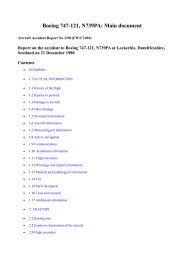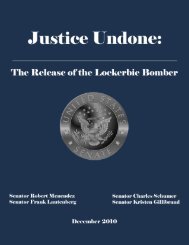REPORT OF THE - Archives - Syracuse University
REPORT OF THE - Archives - Syracuse University
REPORT OF THE - Archives - Syracuse University
Create successful ePaper yourself
Turn your PDF publications into a flip-book with our unique Google optimized e-Paper software.
who had access to the cable felt they could not justify having seen it while others had not,<br />
in that the information was unclassified and relevant to the U.S. community in Moscow.<br />
The Acting Deputy Chief of Mission in Moscow during December 1988 later testified<br />
before the Commission: "Basically, the situation we were faced with there was that ...<br />
whoever the Communications Officer had distributed the cable to, had information that<br />
was in the cable ... so the choices we had were either to simply leave that .. situation<br />
continue to exist ... or to make a decision to provide the information more broadly."<br />
These concerns were raised at a regular meeting of the senior Embassy staff on either<br />
December 12 or 13. The staff reached a tentative decision that an administrative notice on<br />
the threat information should be posted. The dissemination of such a notice was the<br />
Embassy's broadest distribution system. Informed of the staff's recommendation, the U.S.<br />
Ambassador concurred.<br />
Because Embassy security personnel did not have on hand a 1987 State Department cable<br />
which supposedly provided guidance concerning dissemination of FAA bulletin<br />
information, and because the FAA bulletin itself was unclear in that regard, the Embassy<br />
sent a cable marked "action" to the FAA. That cable, dated December 13, 1988, told the<br />
FAA: "Post plans to issue an internal administrative notice warning employees of the<br />
threat."<br />
The Embassy officer responsible for sending the cable to FAA explained to the<br />
Commission that he "wanted FAA to be aware that we were intending to make a<br />
dissemination of their bulletin ...(so) they could respond to us, and either say, 'Don't<br />
disseminate it; disseminate it with the following caveats.' " The FAA never responded (a<br />
"procedural error," according to the testimony of the FAA's Director of Civil Aviation<br />
Security).<br />
The Embassy posted the administrative notice on the morning of December 14. The<br />
notice was distributed in a manner so as to receive the broadest distribution possible<br />
within the American community in Moscow and was intended to reach contract<br />
employees such as painters and chauffeurs, as well as U.S. journalists, business people<br />
and students in Moscow.<br />
351-88<br />
A D M I N I S T R A T I V E N O T I C E<br />
American Embassy, MOSCOW<br />
December 13, 1988<br />
TO : All Embassy Employees<br />
SUBJECT: Threat to Civil Aviation<br />
Post has been notified by the Federal Aviation Administration that on December 5, 1988,<br />
an unidentified individual telephoned a U.S. diplomatic facility in Europe and stated that<br />
sometime within the next two weeks there would be a bombing attempt against a Pan<br />
American aircraft flying from Frankfurt to the United States.<br />
The FAA reports that the reliability of the information cannot be assessed at this point,<br />
but the appropriate police authorities have been notified and are pursuing the matter. Pan<br />
Am has also been notified.<br />
In view of the lack of confirmation of this information, post leaves to the discretion of<br />
individual travelers any decisions on altering personal travel plans or changing to another<br />
American carrier. This does not absolve the traveler from flying an American carrier.










